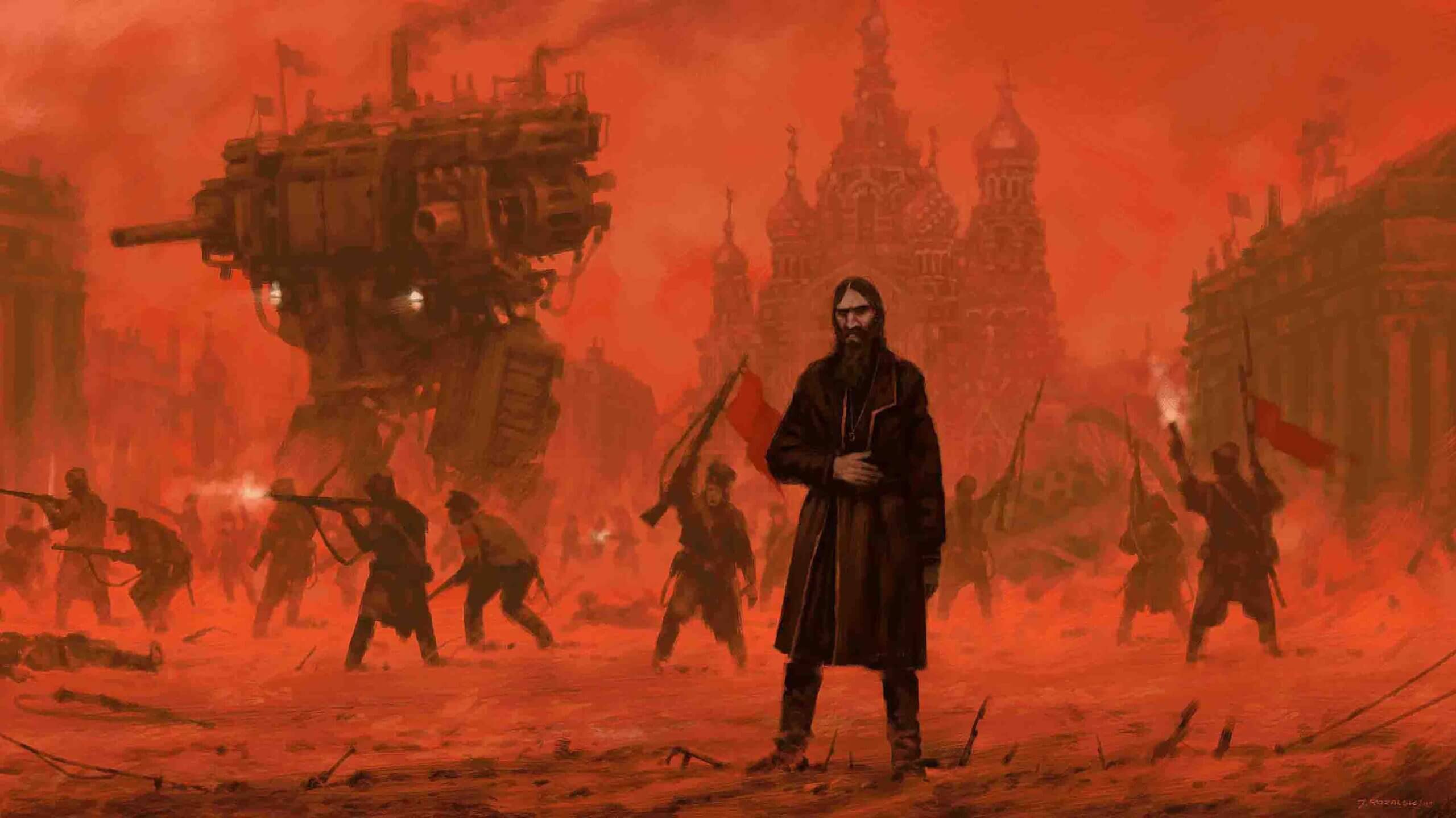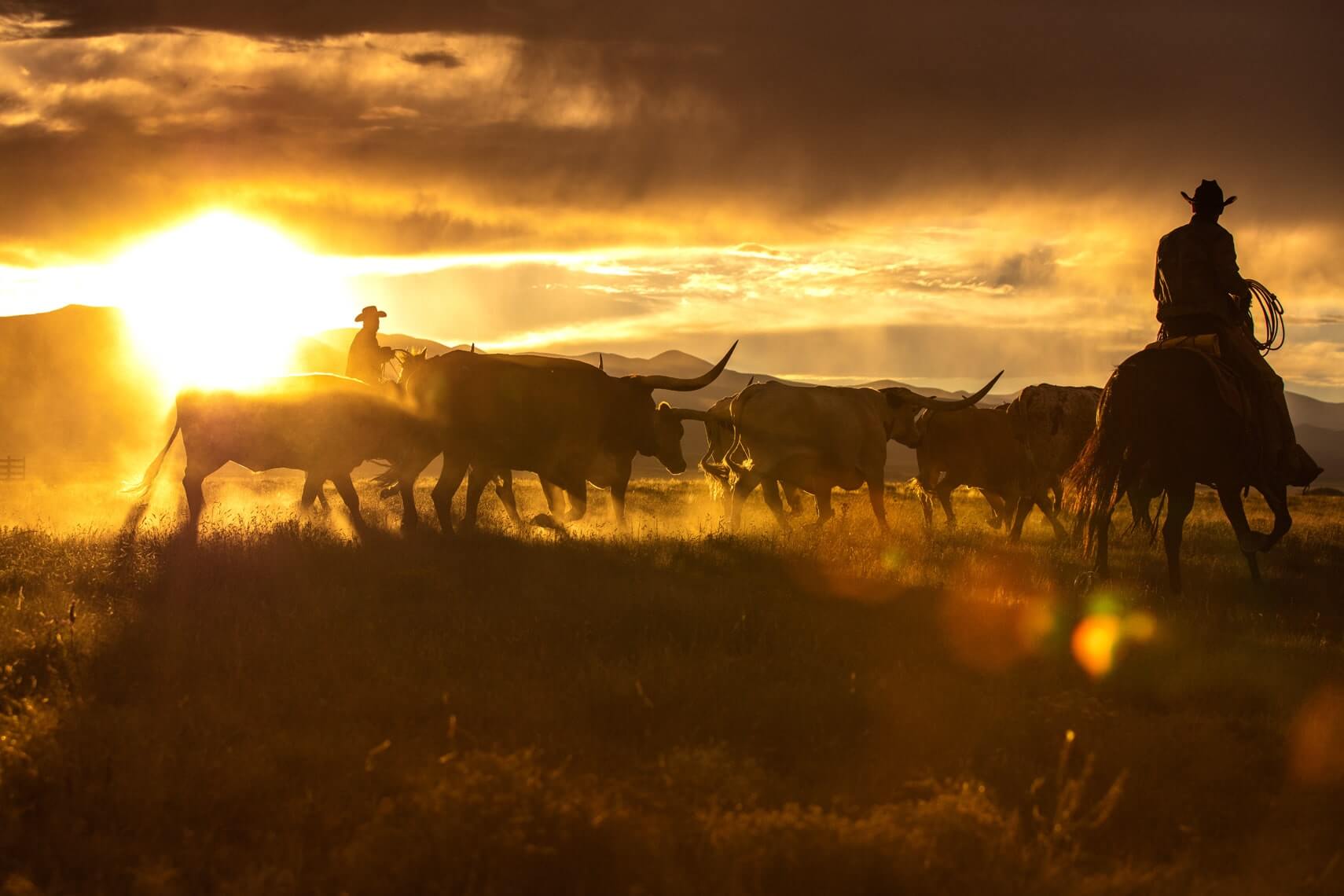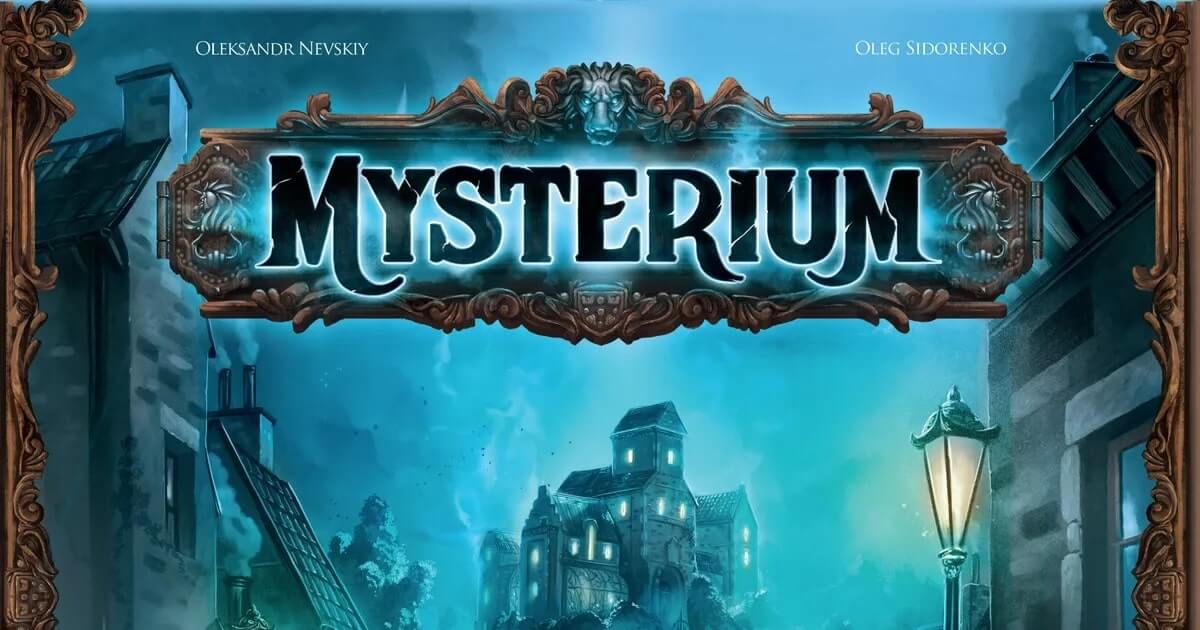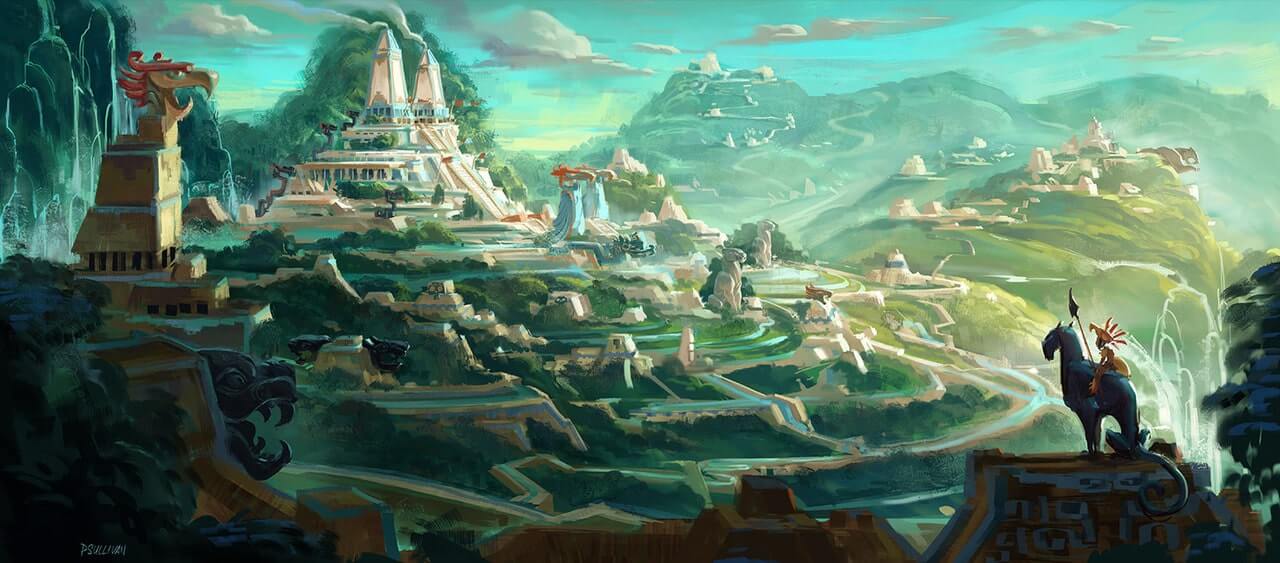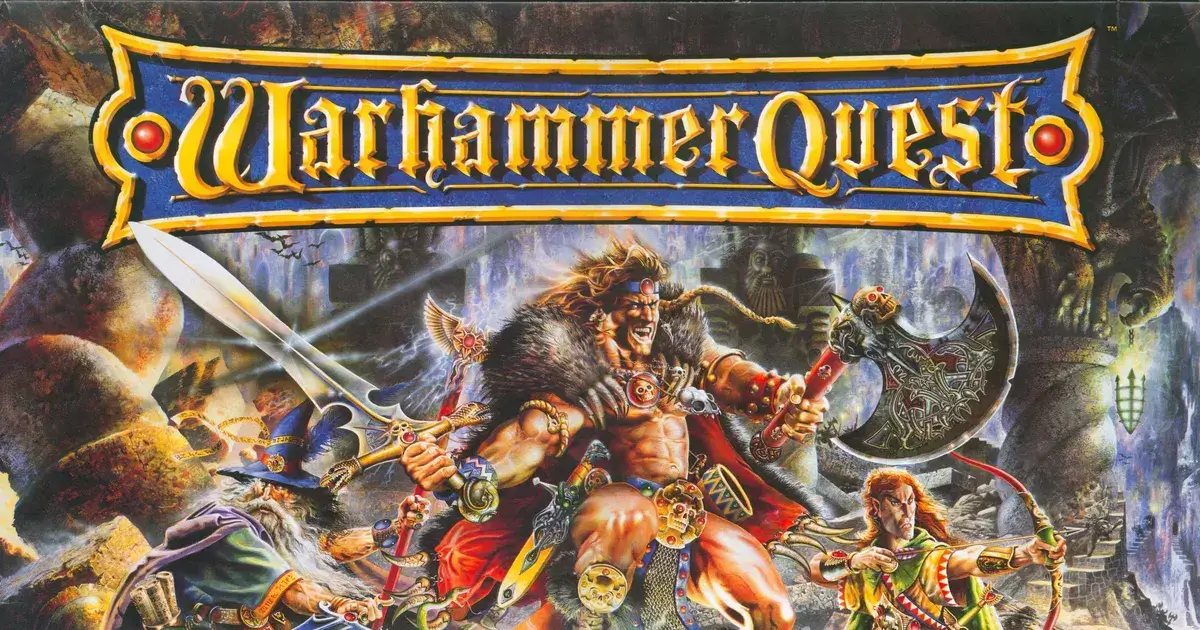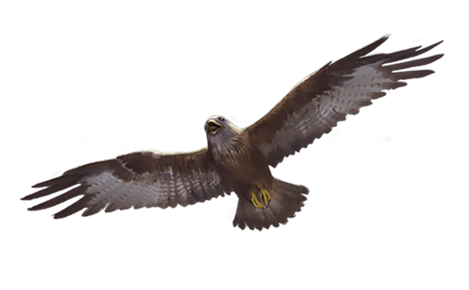I have witnessed the horrors of the Great War firsthand. I have watched as my people suffered and died, as our cities were destroyed and our resources depleted. But even in the darkest moments, I knew I couldn’t lose hope.
The war was a devastating conflict that left all nations in ruins, including ours. We were forced to fight against powerful enemies, like the Saxony Empire and the Nordic Kingdom. But the greatest threat came from the capitalistic city-state simply known as “The Factory”. They fueled the Great War by creating mechs, towering machines of metal and steam that seemed unstoppable.

But despite the destruction, we must not lose hope. We must rebuild our once-great nation to create a new future for our people by focusing on our infrastructure, rebuilding our villages and cities, and ensuring we are well-equipped in case of another war.
Now, The Factory has shut its doors. With no one to maintain control over it, everyone is vying to become the new leader of The Factory and dominate Eastern Europa. If there’s any chance for our nation to regain its long-lost glory, we must join the battle.
But as always, there are new challenges on the horizon. Even though we have built our own, the mechs pose a threat with their destructive power. The Rusviet Union is a force to be reckoned with, boasting a vast army and cunning tactics, and the Crimean Khanate is always difficult to pin down with their nomadic lifestyle.
But we are ready. We have learned from the past, and are determined to create a better future for our people. As the leader of my nation, with my trusty companion by my side, I will overcome any obstacle that lies ahead and make my people proud.

This is the story of Scythe, one of my favorite board games of all time set in an alternate version of Europe in the aftermath of the Great War, where different nations compete to rebuild their countries and establish control of the land. If you’d like to know more about Scythe, keep reading as I tell you all I know about it.
Overview
Scythe is an asymmetric engine-building board game for one to five players also featured on our list of board games everyone should own. It’s called asymmetric because, in Scythe, each player takes the role of the leader of a faction with different abilities, weaknesses, and strategies. Also, each player receives a different playmat, meaning there are various combinations of factions and playmats each with different power levels. This unbalance doesn’t harm the game though – in fact, it makes you want to try several combinations and get to know each one.
When you begin a game of Scythe, you have almost nothing. Starting the game with just your character and two workers, you may feel the pace slow at first. But as the game moves on, almost every action you take helps you build your engine and strengthen your faction, and that’s why we consider Scythe an engine-building game.
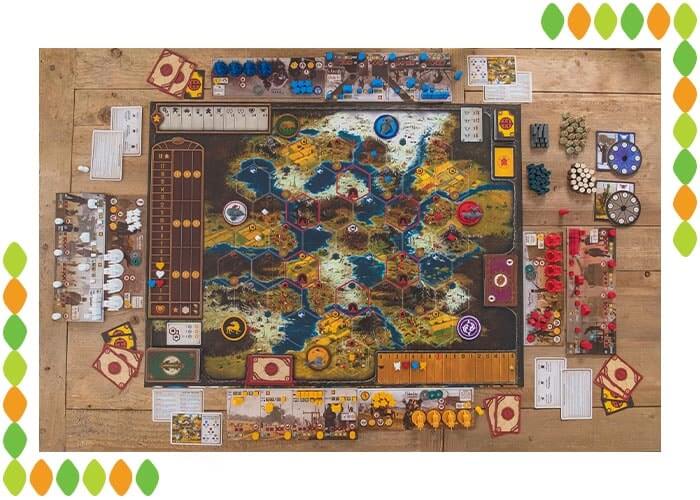
Like most Stonemaier board games, Scythe features a unique and clever solo mode controlled by the AI known as “The Automa” created by the Automa Factory. This AI that plays using a deck of cards, features multiple difficulty levels to suit your needs and poses a great challenge for the player. But even though it has an awesome solo mode, I wouldn’t recommend Scythe to solo gamers, as the full potential of the game is unlocked when playing with human players, especially more than three.
Scythe is set in an alternate-history version of 1920s Eastern Europa where humans have created massive structures known as mechs, used as both vehicles and weapons, and they unleash them into battle triggering the Great War that left no victors. Now, you must fight to regain your nation’s lost glory and move on from the ruins of war. As the rulebook describes, “It is a time of farming and war, broken hearts and rusted gears, innovation and valor.”
This alternate world was created by the Polish artist and illustrator Jakub Różalski. When Jamey Stegmaier, Scythe’s designer, stumbled across Jakub’s artwork online he reached out to Jakub and proposed to design a game set in that world. Since then, Jamey and Jakub have continued their collaboration on further expansion for Scythe. You can view Jakub’s artwork in his gallery here.
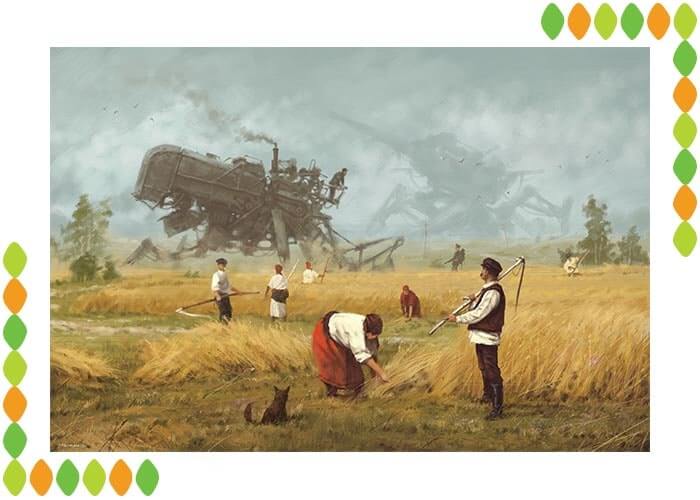
So why would a game about war-struck nations and giant war robots be called Scythe? As Jamey notes in the rulebook, scythes are tools used both in farming and as weapons in battle. This perfectly captures the combination of these two elements in the game. “Your workers rely on the protection of your military just as much as your empire depends on the resources they provide.”
Also if you check the box cover art, you can see mechs shooting at each other in the background, all while some farmers are peacefully watching from a distance and working on their crops. This really corresponds with the atmosphere of the game, where you are rebuilding your empire in the midst of battle.
How to Play
Scythe is played on a big game board of Eastern Europa with The Factory at the center and the faction home bases surrounding the map. Players move around the board collecting and spending resources to upgrade technologies, build structures, and engage in battles. The board is divided into several hexes each with a different terrain type, such as mountains, tundras, and lakes.
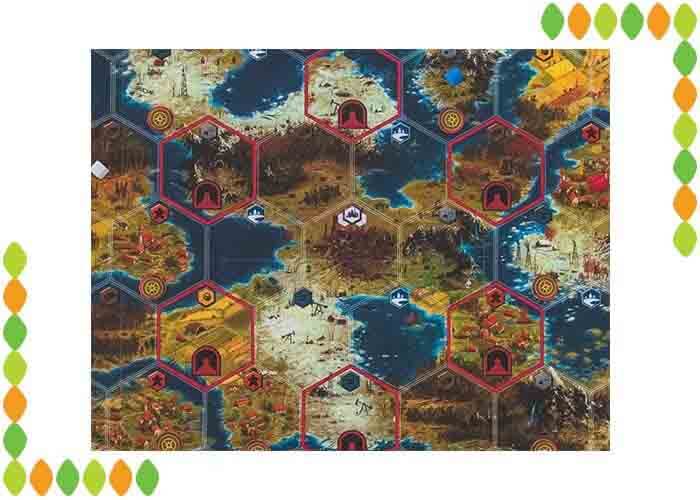
To begin a game of Scythe you must first set up the game board. Place the combat, factory, objective, and encounter cards in their determined spaces. Place encounter tokens on hexes containing the encounter symbol. Randomly draw a structure bonus tile and place it on the board. Place the resources and coins in everyone’s reach and set the two power dials aside for now.
Now comes the most suspenseful and impactful moment of the game, drawing mats. First, randomly deal each player one faction mat. This determines the color, position, and abilities of each player. Then deal each player a random player mat. These determine the costs and rewards as well as the combinations of actions.
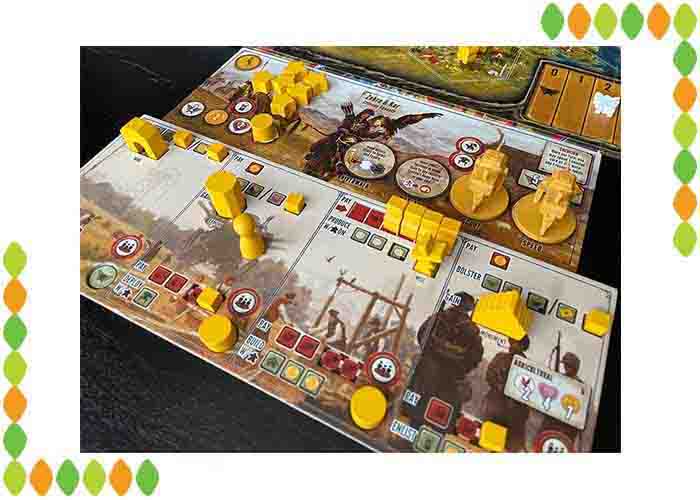
Begin by placing your tokens on the designated spots on your player mat and your mechs on your faction mat. Give each player their starting coins, cards, power, and popularity based on their mats. Finally, place your character miniature on your home base with two workers on the two adjacent hexes.
Now you’re ready to begin a breathtaking game of Scythe!
The faction mats contain descriptions of your mech and special faction abilities. The player mats contain four boxes, each describing an action you can take. On each turn, players choose one of these four boxes and perform the actions in the box as they wish. The game continues in this way until the end of the game is triggered.
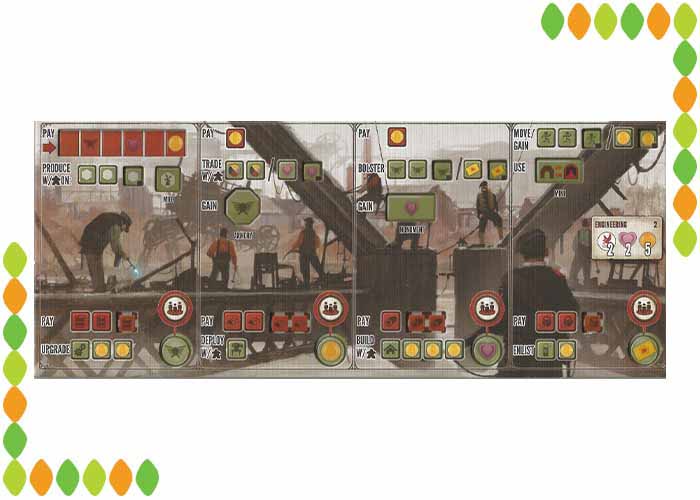
As you can see, each box shows two sets of actions, we’ll call them top-row and bottom-row actions. Players can choose to perform only the top-row action, only the bottom-row action, or both going from top to bottom. Keep in mind that players aren’t allowed to repeat actions in a row, meaning you have to choose a different box each time on your turn.
The top-row actions allow you to move around, collect coins and resources, and strengthen your military force. The bottom-row actions require you to spend resources to gain better benefits. Let’s go over the actions one by one.
First we have the “move” action, allowing players to move their pieces around the board. These pieces could be your character, mechs, or workers. By moving your pieces you establish control over more strategic territories, get access to more resources, threaten enemies to battle, complete objectives, and ensure you can reach further into the map.
Note that movement has certain rules and restrictions, like mechs moving farther and faster than workers. Or the fact that you cannot move in, out, or through lakes. One of the main restrictions of movement is that players cannot move across rivers. This isn’t something minor, seeing as players are all trapped in only three hexes surrounded by rivers at the beginning of the game. There are multiple methods to get out of this enclosure, and you’ll get to know them soon.
The next action is the “bolster” action, which increases combat capabilities for players. By performing this action, you could either increase your power by moving your power token up on the track, or you could draw combat cards that add to your power when battle commences.
Next up we have the “produce” action which concerns workers gaining resources. As mentioned before, each hex has a certain terrain and by producing in these terrains, players gain different resources. You can get metal from mountains, oil from tundras, wood from forests, food from farms, and workers from villages. The number of workers determines the number of resources produced.
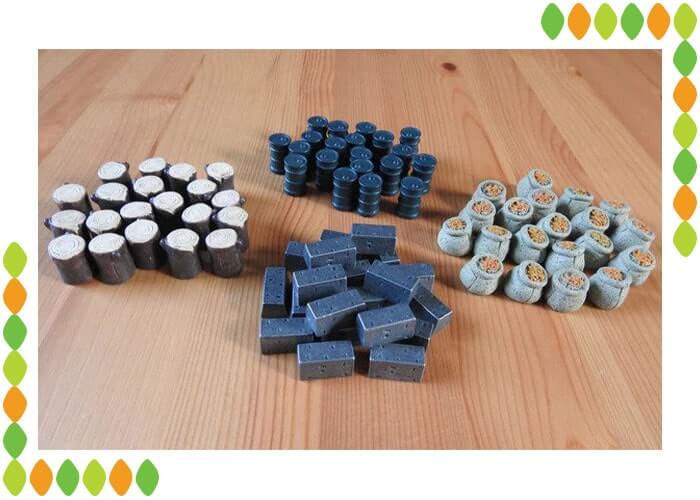
But what if you don’t have access to a certain type of resource? Here we arrive at the final action, the “trade” action. This requires players to spend a coin in order to gain any two resources. While you have to pay money as opposed to the free produce action, you are free to choose any resource you want.
Next up we have the bottom-row actions. First of all is the “upgrade” action. By spending oil, players can upgrade their actions by removing any one of the wooden cubes from the top part of their player mat and placing it in any empty space at the bottom.
This helps players in two ways; in addition to revealing more symbols to top-row actions and making them stronger, upgrading also reduces the cost for bottom-row actions helping the player perform actions easier.
Next is the “deploy” action which requires players to spend metal to build and deploy a mech. After spending metal, you are free to choose any one of your four mechs and place it on the board next to one of your workers.
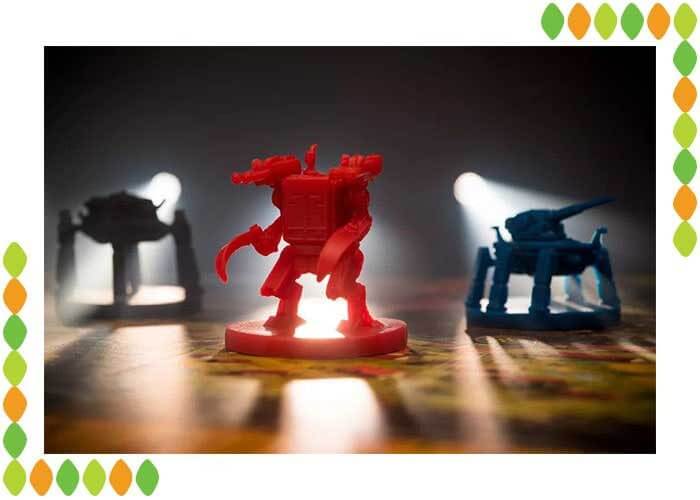
Building mechs benefits you in a bunch of ways. Firstly, mechs are weapons in war, they are the main combat units in the game other than the characters. Secondly, mechs are vehicles, allowing you to move further and faster on the map while transporting your workers to places they couldn’t reach on foot. Lastly, each mech you deploy unlocks a special ability unique to your faction, like faster movement or the ability to cross rivers.
After that, there is the “build” action that allows players to build structures on the board by spending wood. These structures maintain control over territories, and grant players coins based on the structure bonus tile, in addition to unlocking bonuses.
For example, by building a monument, you can get one popularity each time you bolster, or you could build a mill to produce more resources in that hex.
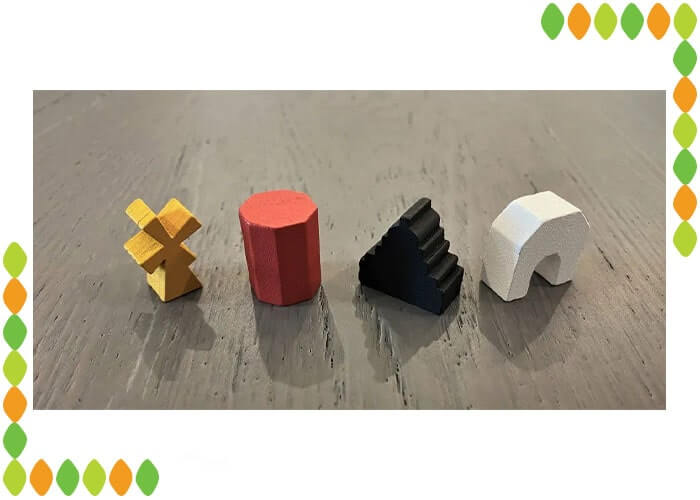
And finally, my favorite, the “enlist” action. By spending food, players can enlist recruits to their faction. After paying the food, you must remove a cylinder token from your player mat, exposing a benefit, and place it on the designated spots on your faction mat, granting an instant benefit. The exposed benefit grants you bonuses when you or your neighbors perform that action.
Let’s say for example, you enlist the upgrade action. From now on until the end of the game, whenever you or one of your neighbor players upgrades a technology, you get one power. This means you get advantages from your neighbors’ actions. Pretty nifty, right?
And these are all of the actions in the game. Now let’s talk about the differences between each player mat. At the setup, the coins, popularity, and first player are determined by each player’s mat. Other than that, the position of the top-row actions differ from each other creating various top and bottom-row action combinations.
Also, the costs and rewards of bottom-row actions are different for each player. One player may gain three coins from upgrading, while another may get no coins. This causes strategies for each player and each faction to be different every game, increasing the game’s replayability.
At the top-left corner of the game board, you can see a track with different symbols. This is called the triumph track and concerns the end-game trigger. The triumph track contains various spaces for players to place stars. By completing each of the requirements on the track, players can place stars on it. Some examples are deploying all four mechs, completing your objective, reaching the end of the power track, or winning a battle.
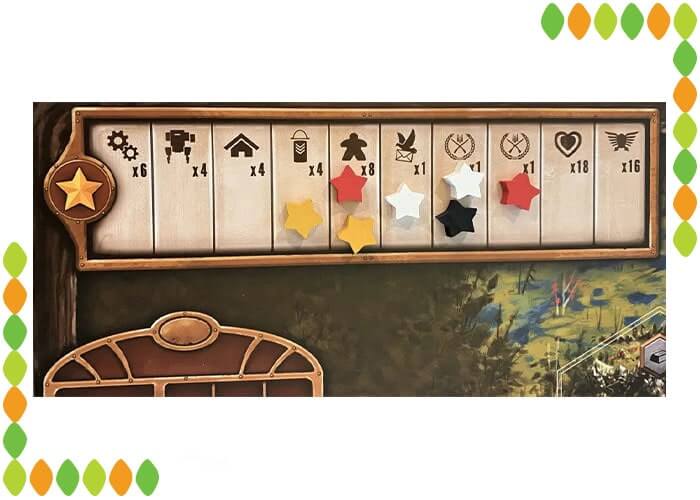
These requirements are the result of your actions throughout the game, meaning that you don’t really have to focus on them from the beginning of the game. If you play well, the stars will come to you.
Whenever any player places their sixth star on the triumph track, the game ends immediately, without even finishing the current turn. This doesn’t mean that player wins, though. You must then count the scores for each player, and the highest score wins the game. Remember that points are coins, so throughout the game you’re actually spending and collecting victory points instead of money.
And that concludes the summary of the gameplay of Scythe. There are still many more events and rules in the game, like encounters, reaching The Factory, and combat which you can figure out for yourself.
How to Win
Throughout my years of playing board games, I’ve never played any board game as much as Scythe. I’ve lost count of how many games I’ve played, but I’m certain it’s a three-digit number. That’s why I feel like I have a good understanding of the game and its strategies. Here I’ll point out a few of the most important tips to help you win every game of Scythe you play.
Be Loved, Not Feared
The popularity track has no benefits throughout the game, but it is the most important one, I think. When the game ends, players get points based on three criteria; stars on the triumph track, controlled territories, and remaining resources (they also get points from the structure bonus tile).
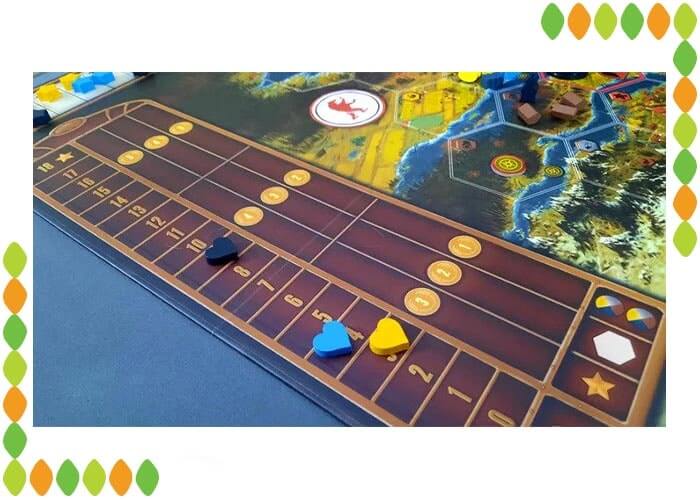
But the number of points rewarded for each one is determined by each player’s position on the popularity track. The track is divided into three tiers, with each tier increasing the rewarded points. This makes a huge difference between players’ points at the end of the game.
For example, a player in the third tier with four stars gets more points than a player in the first tier with six stars (4×5 > 6×3). So always be aware of your position on the popularity track, especially when you get close to the end-game.
Worker’s Insurance
There are multiple ways to lose popularity, but the most common is by scaring off workers. Workers are not combat units, meaning they will escape to their home base if confronted with mechs or characters. Or if they’re accompanied by combat units, they will escape if they lose the battle.
By utilizing this rule, you can raise defense for your territories by gathering workers. If you feel that your character is in threat to be attacked, you could gather mechs to get stronger in battle. But you could also put a few workers next to your character. This means any player attacking your character will lose popularity, which is mostly not desirable.
Don’t be mistaken, this tip doesn’t always work, as sometimes players are okay with losing popularity but instead winning a battle, so be cautious with it.
Additionally, if a player enters a hex with workers and scares them off, their movement ends there. This means by placing workers on surrounding hexes, you can block off players from reaching certain spots.
Two in One
As mentioned before, players are allowed to perform two actions in their turn, the top and bottom-row actions, if they can spend the required resources. So, if you want to make the most of your turns, it’s better you have the resources for the bottom-row action so that you can perform two actions in one turn.
Let’s say you want to move your workers, and beneath the move action is the upgrade action which costs two oil. It’s better to take a trade action first, gaining two oil, so that on your next turn, you can upgrade a technology after your move.
Watch Out for the End
There are no limits to how many stars you can get in a single turn. In an extremely rare best-case scenario, it’s possible for a player to get all six stars in one turn (two for winning two combats, one for finishing the bottom-row action, one for maximum popularity, one for a completed objective, and the last one could be gained by taking an action on an encounter card).
While I’ve never seen this happen nor do I think it will happen, it’s much more common for a player to get three or even four stars in a turn. This means while you think you are far from the end and have time to get more points, suddenly a smart player takes a super-turn and the game ends with you in shock and regret.
This is why you should always keep an eye out for other players, what they have done, and what they can do.
Spread ‘Em
As I mentioned, players get coins at the end of the game based on their territories, and territories are much easier to increase than stars or resources.
The catch is that the more territories you control, the less power you have over them, and it’s more likely someone will kick you out of them. But if it’s the last round, especially the last turn, there’s less risk of losing territories.
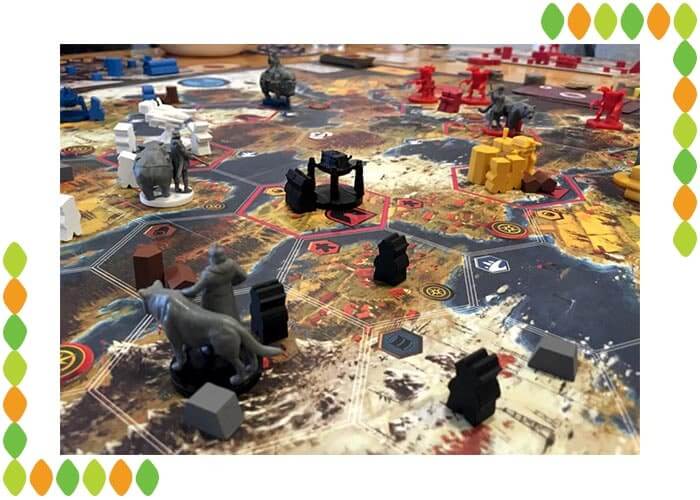
And this is why you should use this trick. If you feel like the game is ending soon, you should try to spread your pieces around the board. Take full advantage of the fact that mechs can drop off workers behind during their movement.
The Old Trick
This one is for the more advanced Scythe players out there. Once in a while, you’ll find yourself in such a position;
It’s close to the end of the game, and the player after you has just one star left. When their turn comes, they will get their sixth star and end the game. Moreover, if they decide to use the previous trick, they can gain a huge advantage.
So, if they’re going to get their sixth star anyway, why don’t you give it to them in your turn? The old trick goes like this; your final action will be the move action, spreading your units around to get more territories, and a single unit attacking the winning player.
Remember, you have to lose this battle. By doing so, you’ll lose a territory and give a star to your opponent, but they don’t have the option to spread around anymore because the game ends in your turn. And if they lose the battle on purpose, well, that’s just a free star for you. Cheeky!
The old trick is a risky one and doesn’t always work, but when it does it’s the most satisfying way to win Scythe while others are in shock at what just happened. So be sure to briefly calculate the outcome before you go for it.
These were a few of the tricks I’ve learned in my many games of Scythe that slowly but surely increase your chances of winning, so be sure to make use of them.
Factions
While the tips I told you before help you to win Scythe, they’re nothing unless you are familiar with your faction and its strengths and weaknesses. Now let’s go over the five factions and see what they’re all about.
The Polania Republic
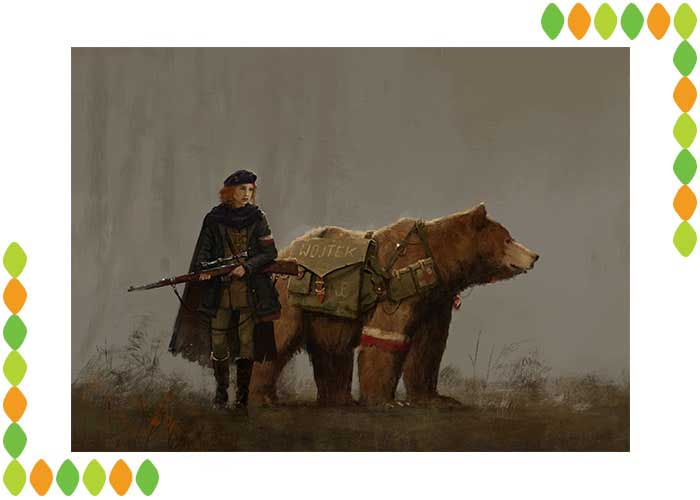
Anna and Wojtek have the Meander ability that allows them to choose two options from encounter cards instead of one. Encounter cards are drawn when a character enters a hex with an encounter token. These cards each feature three choices the player must choose from, granting bonuses to them. Because Anna can choose two of them, encounters are extremely helpful to the Polania player.
And luckily for them, Polania is the most flexible faction in terms of movement. Once they deploy their Submerge mech, not only are they allowed to move in and out and through lakes, but they can teleport from one lake to another, virtually granting them access to every hex on the board.
Also, the Camraderie mech prevents them from losing popularity when scaring workers off after winning a battle. This makes Polania a force to be reckoned with, as they have no regard for workers in a battle, rendering the worker’s insurance trick useless.
The Rusviet Union
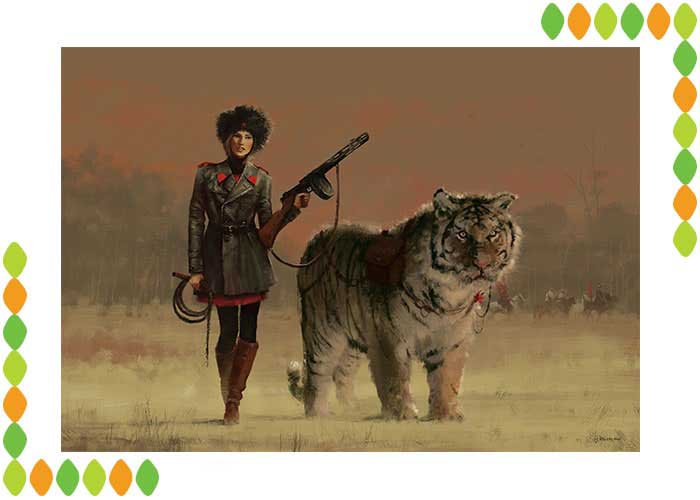
Olga and Changa have the Relentless ability, allowing them to take repeated actions in a row. This means, for example, while other players can move every two turns, the Rusviet player always has the option to move.
They also have a mech that unlocks The People’s Army, which allows their workers to participate in battle, making Rusviet the strongest faction in battle in their best form (character + all mechs + at least one worker). The Township mech also allows them to teleport between villages and The Factory, causing them to usually be the first player to reach The Factory.
The Saxony Empire
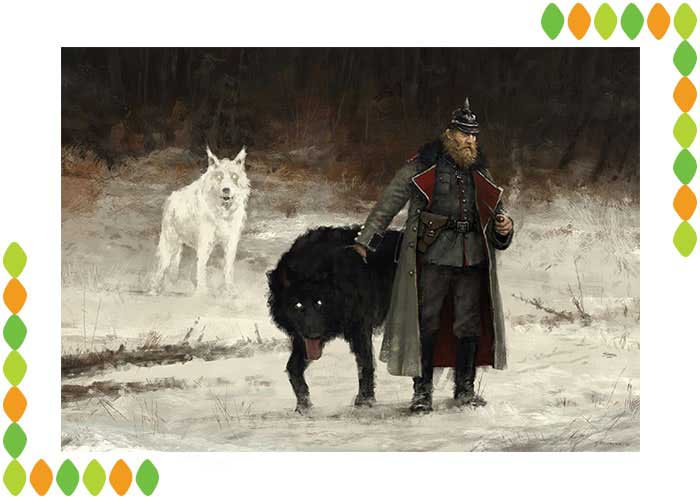
Gunter, Nacht, and Tag have the Dominate ability. During the setup, players draw two objective cards, but they can only get a star from one of them making the second objective useless. Also, they only get stars for winning their first two battles.
This doesn’t apply to Saxony, as Dominate allows them to get limitless stars for completing objectives and winning battles. This makes them a feared opponent throughout the game, especially at the beginning when everyone is weak. The best course of action for Saxony is to quickly win battles and end the game as soon as possible.
I consider Saxony as a weaker faction, based on the games I’ve played. The reason is once the game proceeds a few rounds, other factions have advanced more than Saxony (this isn’t always true). But out of the games where Saxony was the winner, most of them were short and quick games with low scores, so keep this in mind when playing as Saxony.
The Crimean Khanate
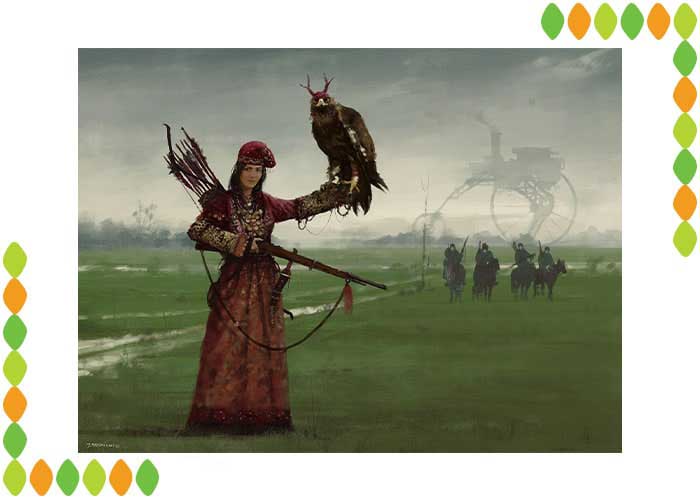
Zehra and Kar have access to Coercion, which allows them to spend one combat card as if it were any one resource. This is the best ability in the game, in my opinion. You can perform bottom-row actions much more easily when you have one less resource to worry about.
And combat cards are easy to collect with the bolster action and the enlist action. There are even cases where after upgrading, the cost of an action is a single resource and you can just spend a combat card to perform it.
Crimea’s Wayfare mech is also an interesting ability. It allows the player to move to any inactive home base in the game from anywhere you are. While it’s not as strong as Polania’s Submerge, it gives Crimea a boost, especially in low-player games where inactive home bases are more.
The Nordic Kingdom

Bjorn and Mox are my favorite pair in the game, and not just because I play blue in every game. It’s because of their Swim ability, which allows their workers to cross rivers with no restrictions. This allows them to quickly spread their workers on the map and gain access to more hexes, especially at the beginning of the game.
I’ve found Nordic’s gameplay to be one of more farming and less fighting, because of their mechs. Even though Nordic is my favorite faction to play with, I think they have the weakest mechs. The Artillery mech allows the player to spend one power to decrease their opponent’s power by two in combat.
That’s just a difference of one power, which usually has no impact on the outcome. The Seaworthy mech is not as bad, allowing them to only move to and from lakes, keeping them safe from opponents (except Polania who can move in lakes, too). It also allows them to retreat into an adjacent lake instead of their home base after losing a battle, creating an opportunity for a counter-attack.
To fully understand each faction’s gameplay strategies, you’ll have to play with them again and again. And even then, you should try different faction and player mat combinations to fully acknowledge the differences. Now you know why I play Scythe so much!
What have you experienced and learned by playing with each of the factions? What’s your favorite one and why?
Expansions
The alternate universe of Scythe created by Jamy Stegmaier and Jakub Różalski isn’t limited to just one game. Since its release in 2016, Stonemaier Games has been constantly publishing expansions and add-ons to the game. Let’s see what we have in store.
Invaders From Afar
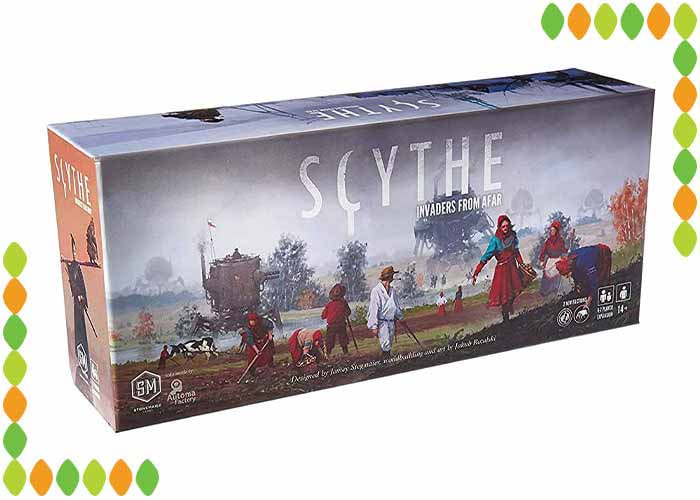
This expansion pack introduces two new factions to the game so you can have more options and even play the game with up to seven players. These factions are Clan Albion and Togawa Shogunate, representing nations far from Europa, who have come to throw their hat in the ring.
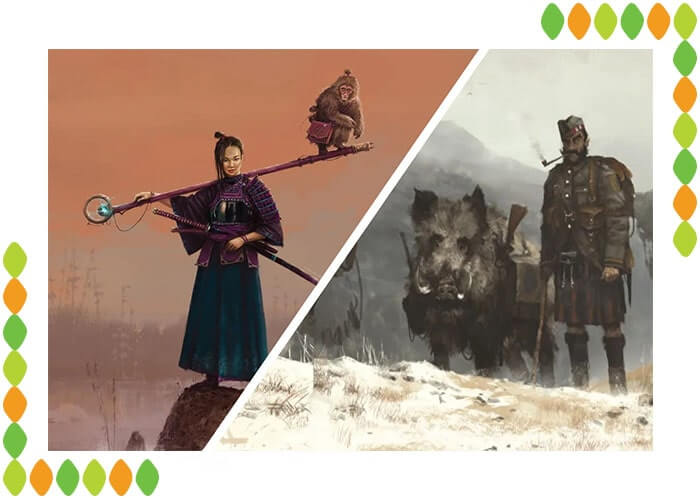
These factions are quite different from the others. For starters, they aren’t trapped in three hexes surrounded by rivers, like other factions. But instead, they don’t have a Speed mech, causing their movement to be slower than others.
Each faction also introduces new components to the game. Albion can place flags in their territories to maintain control and score more points for territories at the end of the game.
Togawa makes use of trap tokens, placing them in different hexes on the map, making it more difficult for opponents to infiltrate. Togawa and Albion both have the ability to teleport to hexes containing flags or traps, making up for their lack of Speed.
Invaders From Afar also adds new player mats to the game, increasing the number of possible factions and player mat combinations. There are some slight modifications to the game’s core rules for more than five players, as well.
The Wind Gambit

The Wind Gambit takes the battle from the ground to the sky by introducing a new unit to the game, the airship. This metal behemoth defies the rules of nature by moving through the skies and striking fear in the heart of the enemy.
Though it seems like a huge threat, the airships aren’t quite hostile. By default they don’t have the ability to control a territory or engage in a battle, rather they can move easily and transport units with themselves. All airships have two abilities, one passive and one aggressive.
The passive ability concerns moving and constructing, while the aggressive ability focuses on wreaking havoc below or fighting in the sky. While it doesn’t change the flow of Scythe in a major way, The Wind Gambit adds two exciting modules to the base game to create new and more challenges for the players.
Rise of Fenris
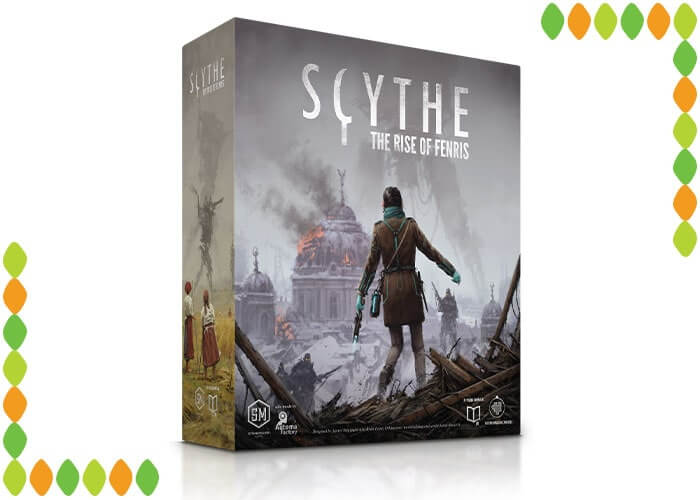
By now you know a bit about the story of Scythe and if you think it’s interesting, wait till you see this gem. Rise of Fenris is a campaign game based on the core game of Scythe, where players represent nations around Eastern Europa fighting for control of the land, while dark forces loom in the shadows of The Factory, waiting for the right moment to strike.
Rise of Fenris consists of an eight-episode campaign where each episode is a game of Scythe, each time with thrilling objectives and modifications. Players play eight games to score points and complete objectives so they can strengthen themselves for the final game. Whoever wins the final episode is the winner of the game.
In this game, each episode provides a rich narrative with exciting events and positive or negative relationships between factions. It also introduces two new secret factions to the game, based on the story. Anything more I add will spoil the experience, so I’ll let you get to know about Rise of Fenris for yourself.
My Little Scythe
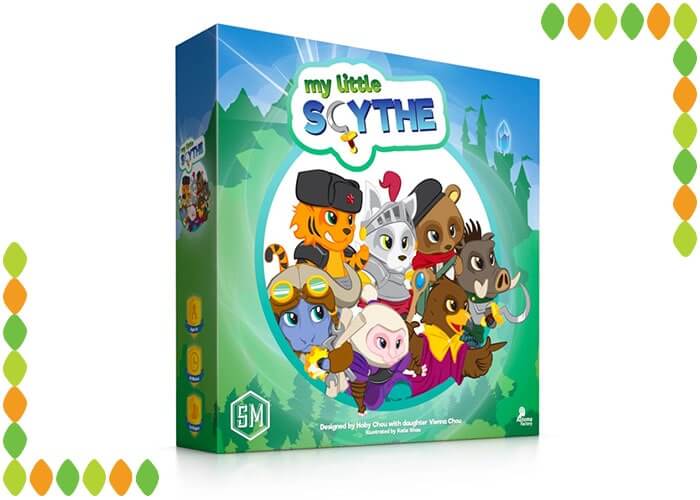
This game came as a surprise to the board game community. Even Tom Vasel of Dice Tower claimed he would “eat a shoe” if such a game was ever released. Originally, My Little Scythe was created as a fan-made variation to the popular board game created by a Scythe fan to play with his children.
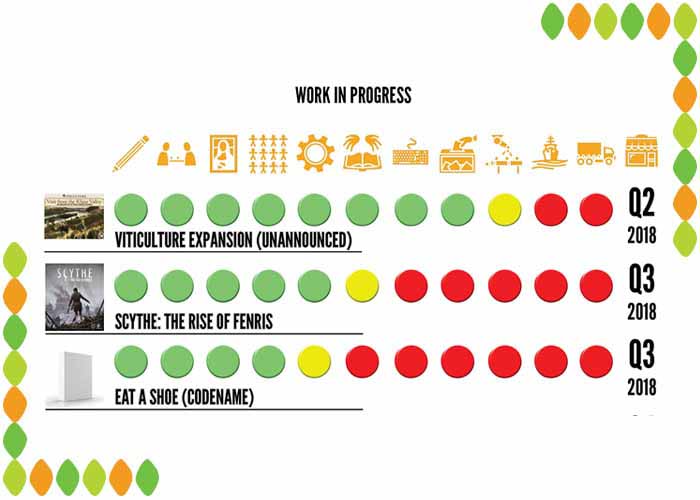
Hoby Chou designed My Little Scythe with the help of his daughter, combining the two very different worlds of Scythe and My Little Pony, and he published it as a print-and-play version online. After causing a spark online, it caught the attention of Jamey Stegmaier who went on to officially bring the game to life with the help of Hoby.
My Little Scythe plays similarly to Scythe. Players each control two animal miniatures, moving around the board, collecting resources, and starting pie fights with each other. Basically, it’s a watered-down family-friendly version of Scythe that helps bring younger gamers around the table.
Stonemaier Games has also released several add-ons and components to the game such as metal coins, realistic resource tokens, metal mechs, modular board, big box, and so on. You can find a list of them here.
Final Thoughts
In conclusion, Scythe combines intricate mechanics with a relatively rich narrative to create a world and a game that is both engaging and challenging. The world-building is top-notch, with each faction having its own unique backstory and culture. The artwork is also some of the best I’ve seen in any board game, bringing the post-apocalyptic world to life. Overall, Scythe is a game that offers a captivating and immersive experience for any player. Whether it’s your first time or your four-hundredth, I urge you to give this game a go!
What do you think about Scythe? Do you think it’s worthy of playing more than a hundred times? Or do you think it’s too overrated? Tell us your opinions down in the comments!

